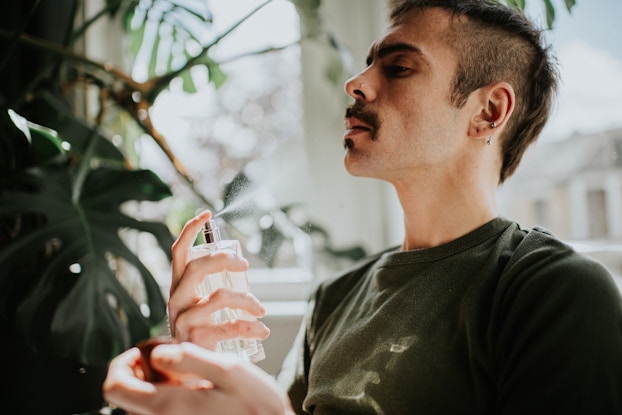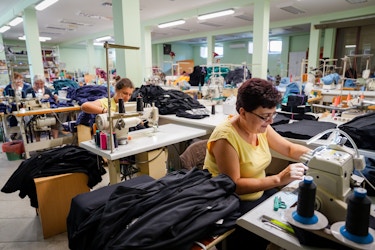
Why it matters:
- Fragrances are the fastest-growing category in the beauty business today, according to Circana.
- Gen Z, including teenage boys, are driving a perfume boom by curating “fragrance wardrobes,” just as sales of affordably priced “dupes” of upscale perfumes saw double-digit gains.
- You can’t smell perfumes online, but social media influencer endorsements have helped entice younger customers to enter the market.
The
fragrance industry is booming. Men are moving beyond inexpensive
aftershaves to invest in premium scents. Gen Z consumers are driving
sales by “cocktailing” multiple fragrances to create unique
blends. Meanwhile, influencers are making it trendy to buy
high-quality dupes of luxury brands. Even the proliferation of GLP-1
weight loss medications are providing a sales bounce.
“When
people start a GLP-1, many find that they are seeking sensory inputs
that they are no longer getting from food and are turning to
fragrances. We see that GLP-1 users are increasing their consumption
of perfume by 23%,” Anna Mayo, Vice
President of NielsenIQ’s
Beauty Vertical, told CO—.
Fragrance
sales perked up over the past two years along with a return to
offices and social activities. “Fragrances are a pick-me-up,”
said Piyush Jain, CEO of New York–based
beauty incubator Maesa.
“We identified it as a growth opportunity.”
Jain’s
observation was on the money—literally. Fragrances comprised the
fastest-growing beauty category in 2024, according to Circana,
usurping makeup, which was the top performer in 2022 and 2023.
Prestige scent sales jumped 12% to command 28% of total prestige beauty sales, which approached $34 billion in 2024, according to Circana. Mass fragrance sales gains clocked in at about 9%, which lagged behind prestige but was the fastest-growing category in dollars in the channel encompassing drug, discount, dollar, and grocery stores.
Fragrances
provide a whiff of hope in a beauty market that is cooling after
three red-hot years. “The end of the beauty boom is in sight,”
said Oliver Chen, Managing Director, New Platforms Sector Head at TD
Cowen, during a Beauty Independent
event in Los Angeles in February. Fragrances, however, will outstrip
growth, especially niche fragrances that bring a freshness to the
category, he predicted.
Generation
Z, men’s fragrances lead the charge
“Perfume
and cologne sales growth is coming from all
demographic segments, though Gen Z is showing the most increase in
consumption, driven by their usage habits of curating a 'fragrance
wardrobe' rather than one signature scent, and looking for a scent to
complement various moods,” said NIQ’s Mayo.
Men,
once associated with drugstore cologne, aftershave, and body sprays,
are trading up. The latest Piper Sandler Taking Stock With Teens
survey, which polled over 13,500 teens, found that fragrance was the
fastest-growing beauty category, rising 25% year-over-year. Notably,
teen boys increased their spending on fragrances by 26% compared to
the previous year.
That
doesn’t surprise Ian
Ginsberg, President of New York City’s C.O. Bigelow Chemists. While
young girls were snapping up pricey skincare over the past few years,
Ginsberg spotted boys gravitating to premium scents. “We noticed
them coming in, sometimes with parents’ credit cards, and buying
prestige fragrances,” he said.
The
fragrance business might conjure up images of your grandmother’s
vanity lined with classics like L’Air du Temps
or Chanel No. 5.
Those brands still have a loyal fanbase, but the boom is ignited by
young shoppers who like experimenting with multiple fragrances rather
than staying faithful to a signature scent.
“Fragrance
layering is trending,” confirmed Noah Rosenblatt, President of
beauty retailer Space NK for North America,
adding that layering builds multiple sales. Younger customers also
support celebrity launches, such as the newest Billie Eilish scent
that just launched at Ulta Beauty.
The scent, called Your Turn,
is the fourth in the singer’s portfolio.
Gen
Z also gravitates to artisan fragrances—not necessarily the big
names of their parents’
generation. “Consumers are going very niche and experimental,”
said Yarden Horwitz, Co-founder of beauty intelligence firm Spate.
Examples she cited include Lattafa,
an Arabian-inspired fragrance that's created a buzz on TikTok, and
d’Annam White Rice,
a tribute to Vietnam's cultural symbol of its livelihood.
[Read
more: How To Turn Deinfluencing Into a Marketing Opportunity]
The TikTok fragrance factor
With soaring interest in scents, brands traditionally known for makeup, skin, or hair jumped onto the fragrance bandwagon. Charlotte Tilbury has expanded into fragrances with a collection powered by emotion-boosting molecules. Moroccanoil leverages its popular shampoo scent with the introduction of fragrances.
TikTok paved the path for fragrances to gain traction even if consumers couldn't sniff them. The hashtag #PerfumeTok provided a platform for posters to describe scents. Brands without the bandwidth to get retail distribution achieved direct-to-consumer sales opportunities thanks to social media. TikTok Shop, the platform's e-commerce feature, has surpassed more than $100 million in sales over the past few years, according to NIQ's Mayo. “It provides a launchpad for new brands to grow their awareness and reach a mass audience.”
[Read more: Trend Forecasters on the 6 Consumer Trends Set to Impact Business in 2025]
Perfume and cologne sales growth is coming from all demographic segments, though Gen Z is showing the most increase in consumption, driven by their usage habits of curating a 'fragrance wardrobe' rather than one signature scent, and looking for a scent to complement various moods.Anna Mayo, Vice President of NielsenIQ’s Beauty Vertical
A tale of two trends: Luxury fragrance sales sizzle as ‘dupes are hot’
The fragrance growth spurt is driven not only by increased unit sales but also by higher-ticketed items. Luxury brands (defined by high-quality ingredients and price points starting at $150) accounted for 12% of prestige fragrance sales and grew faster than the overall category, per Circana. As an example, Carolina Herrera’s Good Girl Blush Elixir, priced at $175, was the top-selling fragrance launch last year, generating $39 million in sales.
The
allure of those premium scents spawned another fragrance trend at the
other end of the price range—the rise of dupes.
Affordably
priced copies of premium products are having a moment. “Look at the
success of the [Birkin
bag–inspired]
Wirkin,”
said Karen Young, CEO of The Young Group. “Dupes are a hot topic in
fragrances, too.”
Mimics
of pricey fragrances have been on the market for decades, but have
achieved acceptance thanks to social media and elevated brands like
Fine’ry
and Dossier.
Created
by New York City incubator Maesa, Fine’ry is sold exclusively at
Target.
“Fine’ry
was born with a mission to democratize fragrance. We feel the best
fragrances in the world shouldn’t be reserved for only those who
can pay hundreds of dollars to buy a fragrance,” said Maesa’s
Jain, adding that Fine’ry went viral on TikTok.
Walmart
also got into the action with Dossier,
a
brand it first discovered as part of its Walmart Start
accelerator program. The Dossier Impressions portfolio at Walmart
includes Ambery Saffron,
inspired by Baccarat Rouge 540 and priced under $50, versus $465 for
the original. Since
its launch in 2019, Dossier has sold over 5 million bottles of
perfume, including over 700,000 units of Ambery Saffron.
There
is an upside to the dupe culture, said Larissa Jensen, Senior
Vice President of Beauty at Circana. There are two different
shoppers: those who buy the original and those on the hunt for a
value alternative. Also, the dupe sometimes serves as a trial for a
trade-up to the original.
The
future of fragrance as a ‘physical wellness benefit’
The link between fragrance and mood will become more critical, and the next fragrance a consumer buys could do more than smell good, experts said. “There is an element of fragrance that is tangible with close to half of consumers saying they're interested in fragrances that provide a physical wellness benefit like to de-stress or get a good night’s sleep,” Circana's Jensen concluded.
CO— aims to bring you inspiration from leading respected experts. However, before making any business decision, you should consult a professional who can advise you based on your individual situation.

Interested in a small business membership?
Find out how the U.S. Chamber of Commerce can help your company grow and thrive in today's rapidly-evolving business environment. Connect with our team to learn how a small business membership can benefit your bottom line and help you achieve your goals.







